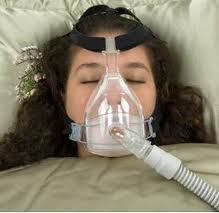Patients who are hypercarbic, hypoxemic or both often require emergency ventilatory support.
 The initiation of positive pressure ventilation following rapid sequence intubation can be life saving. Yet there are significant risks to these procedures.
The initiation of positive pressure ventilation following rapid sequence intubation can be life saving. Yet there are significant risks to these procedures.
Bilevel Noninvasive Positive Pressure Ventilation (Bilevel NPPV, commonly called BiPap) is a noninvasive way to provide ventilatory support to patients without having to intubate them. (1)
BiPap (actually a trade name) consists of providing by face mask or nasal mask (nasal is often better tolerated) an increased airway pressure during inspiration and a lesser baseline pressure throughout expiration.
BiPap may be appropriate in patients who:
–are having an acute exacerbation of COPD
–have an exacerbation of Congestive Heart Failure
–have severe pneumonia
–have status asthmaticus
–have mild post-extubation stridor
Patients who are candidates for or placed on BiPap require close observation as well as monitoring of heart rate, respiratory rate, blood pressure, oximetry, and continuous waveform capnography.
The equipment and medicines for rapid sequence intubation should be prepared in case it becomes necessary.
BiPap is contraindicated in patients who can’t cooperate, who are apneic, or who cannot protect or maintain his airway.
A way to think of BiPap is as continuous positive airway pressure (CPAP) along with inspiratory pressure support.
The airway pressure during expiration is termed EPAP (expiratory positive airway pressure) and is analgous to CPAP (continuous positive airway pressure) or PEEP (positive end-expiratory pressure).
The airway pressure during inspiration is called IPAP ( insperatory positive airway pressure). It is an increase in airway pressure during inspiration above that of the EPAP which can be thought of as the baseline pressure the system is always delivering.
Procedure
First, explain the process to the patient.
Then, apply the mask and initially use 3 to 5 cm H2O of CPAP. Let the patient hold the mask against his face first, and if he tolerates then secure the mask with straps.
Then explain to the patient that the pressure will change periodically and then either sequentially increase the CPAP by 2 to 3 cm H2O every 5 to 10 min or initiate Bi-Pap to support respiration.
Initial BiPap Settings for Respiratory Distress or Failure:
–IPAP of 8 cm H2O
–EPAP of 3 cm H2O for a pressure support (IPAP – EPAP) of 5 cm H2O.
–Give supplemental oxygen
Titration:
“One approach that has been used succesfully in hypoxemic patients in impending respiratory failure is to titrate by raising EPAP and IPAP in tandem in 2 cm H2O steps, allowing a reasonable trial period (e.g., 5 minutes) at each level before increasing further. If the patient is hypercapnic, it may be better to raise the IPAP in 2 cm H2O steps, with the EPAP being kept stationary or increased in a ratio to IPAP of approximately 1:2.5 (EPAP:IPAP). The intrinsic PEEP (PEEPi), or auto PEEP, cannot be measured by the noninvasive ventilator: therefore, EPAP should generally be maintained below 8 to 10 cm H2O to be certain that it does not exceed PEEPi in patients with obstructive lung disease. The IPAP must always be set higher than EPAP by at least 5 cm H2O.” (2)
The Goals of BiPap
“The goals are to reduce the patient’s work of breathing, improve comfort, meet oxygen saturation goals, improve gas exchange, foster patient cooperativity, and maintain a respiratory rate < than 30 breaths per minute. If the patient is not approaching these goals after the first hour of NPPV, then strong consideration should be made for rapid sequence intubation and institution of invasive mechanical ventilation.” (3)
(1) Manual of Emergency Airway Management 4th ed, 2012. RM Walls and MF Murphy, pp. 54 – 58.
(2) Ibid., p. 56.
(3) Ibid., p. 56.




